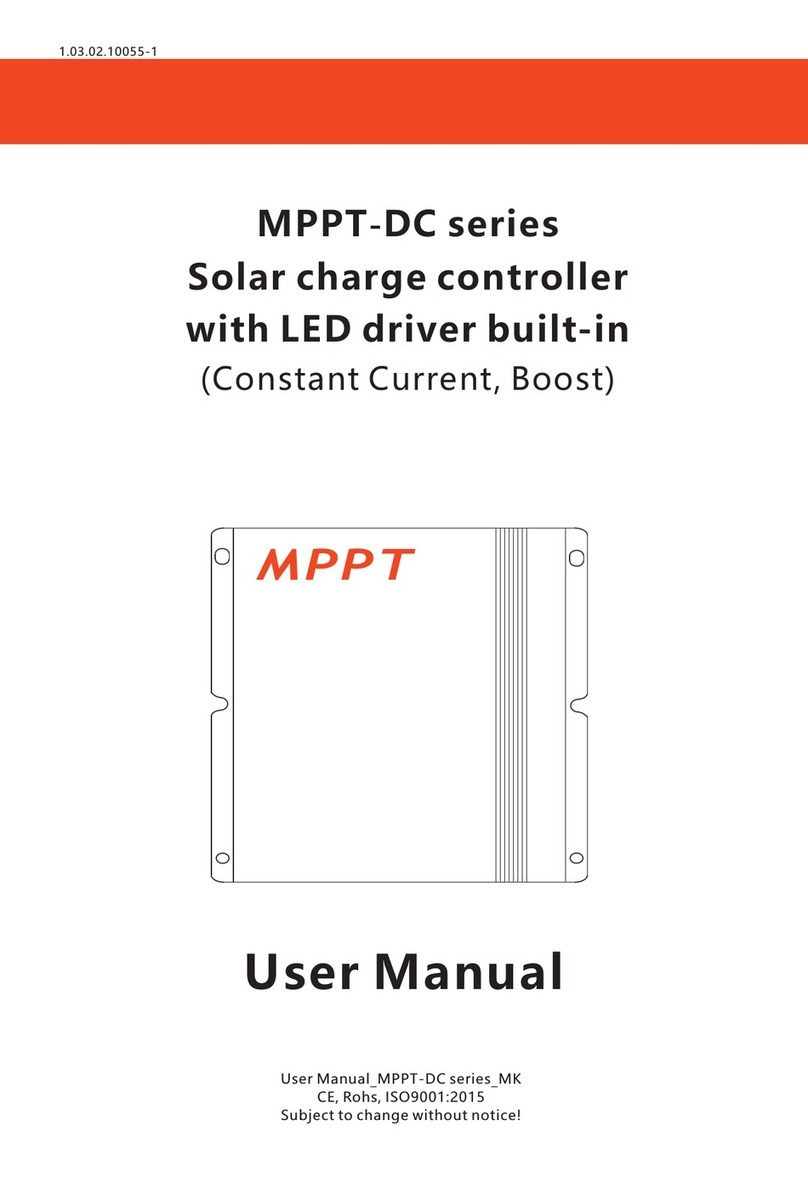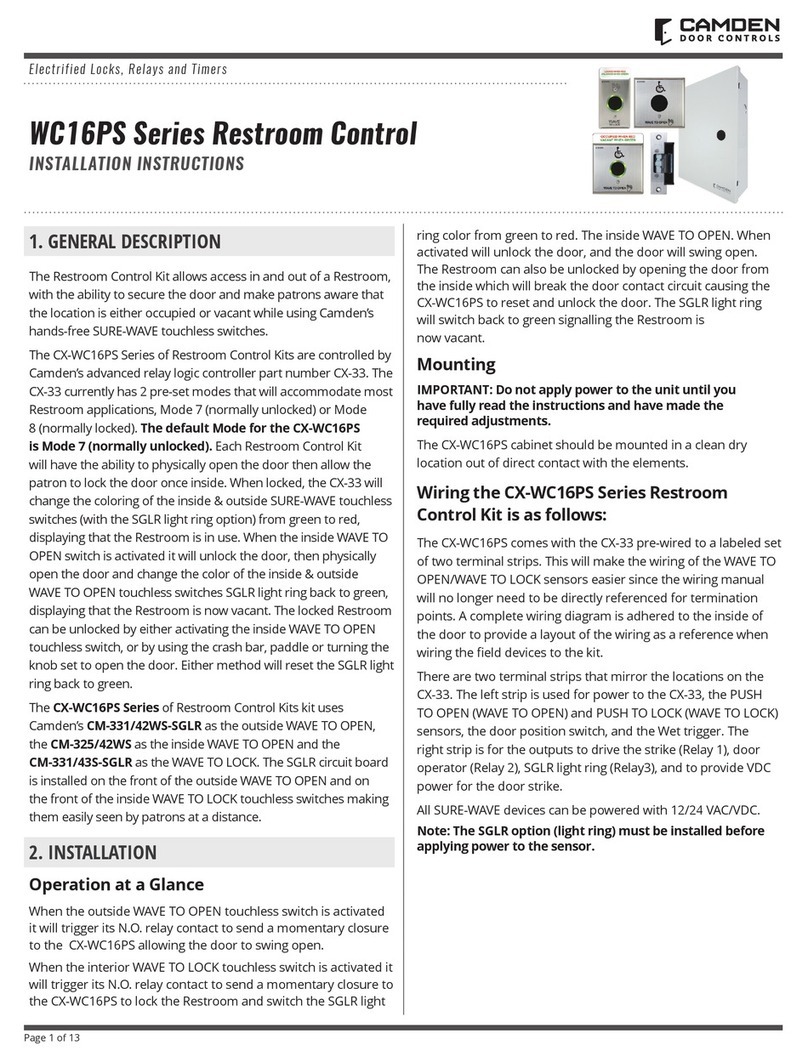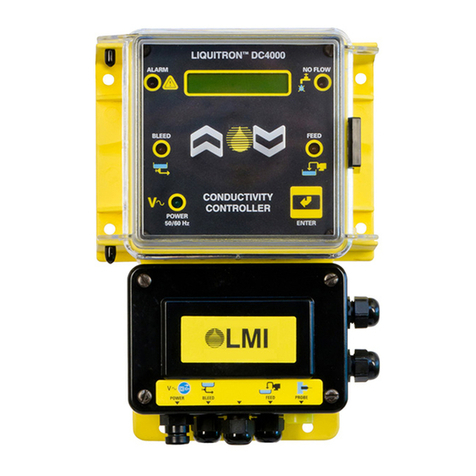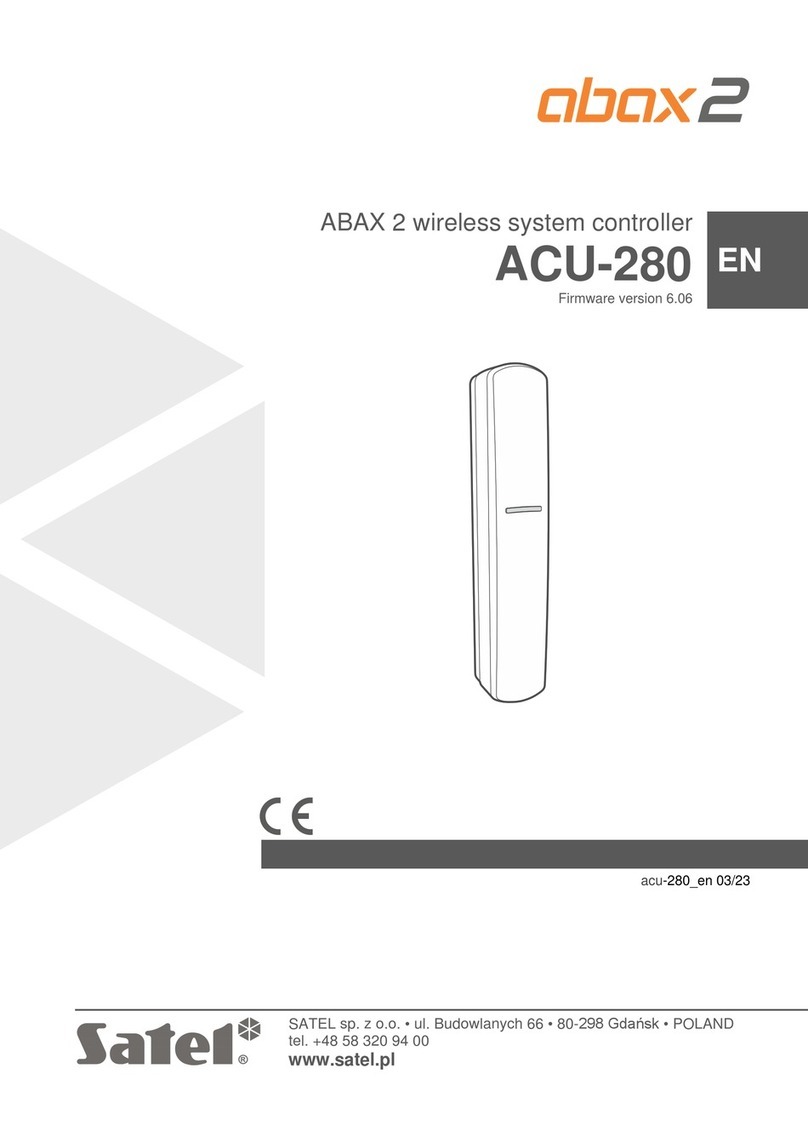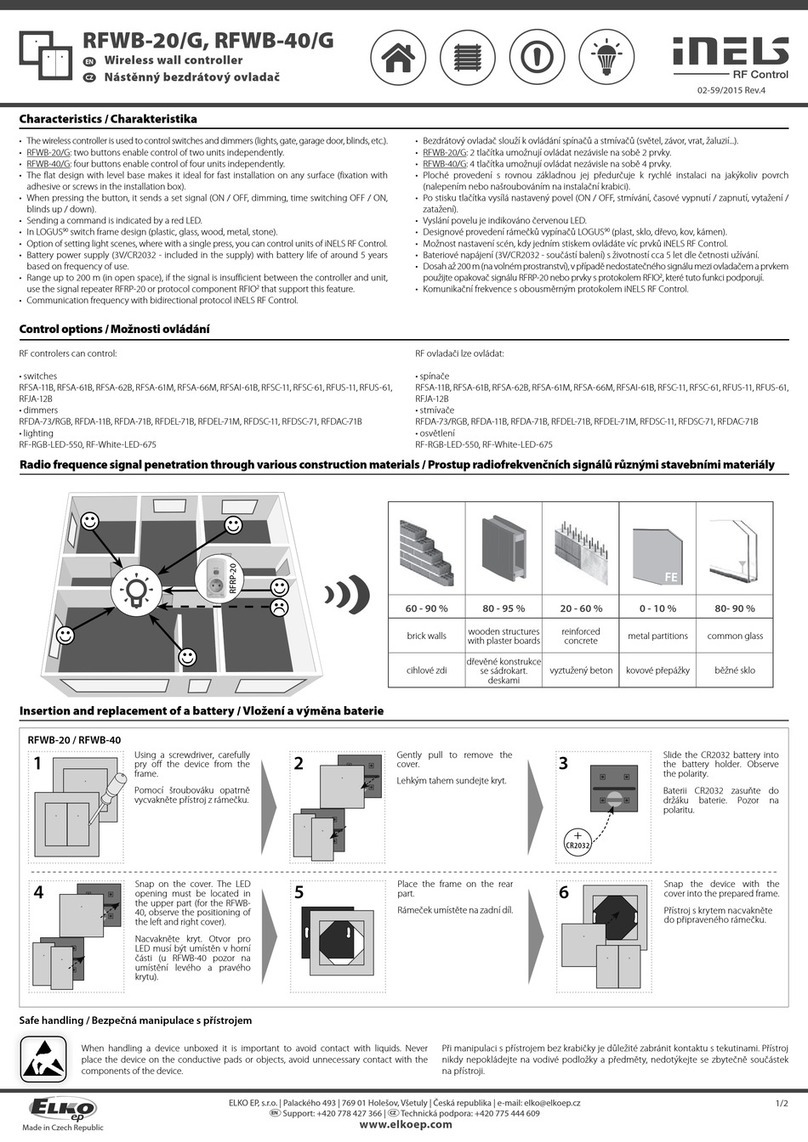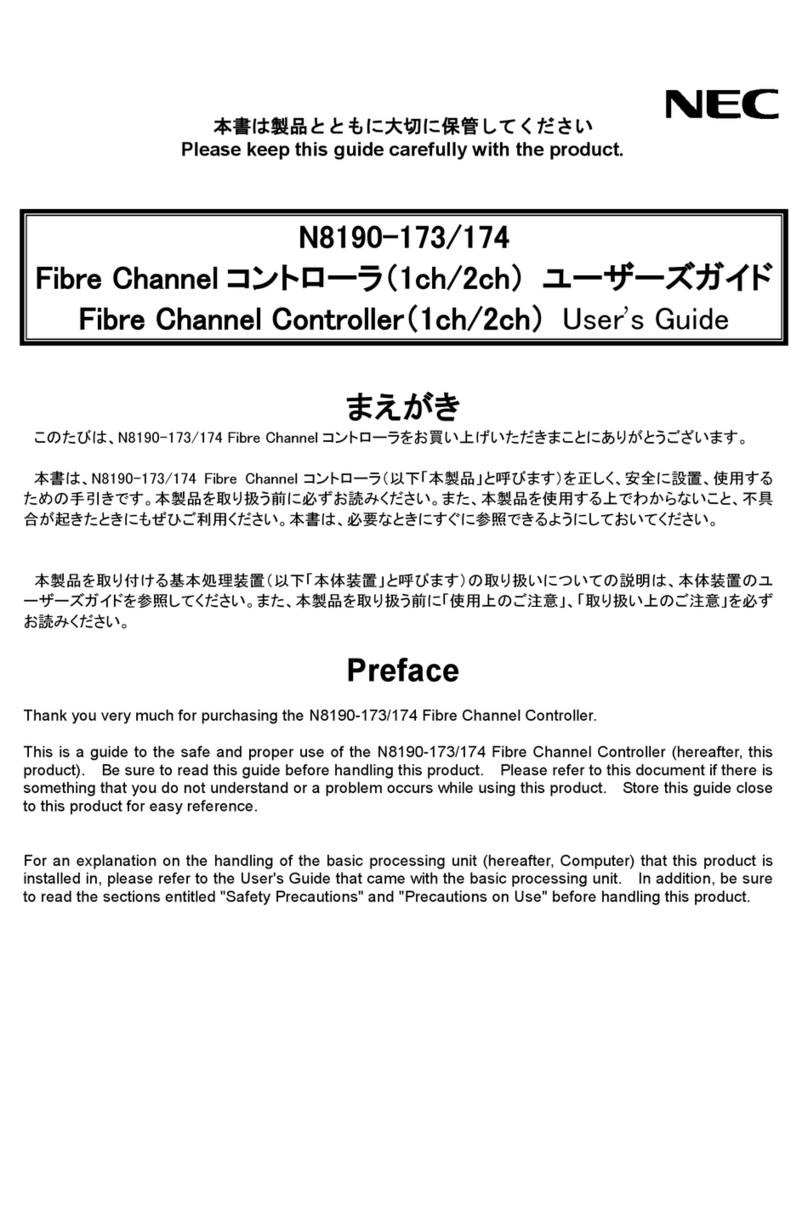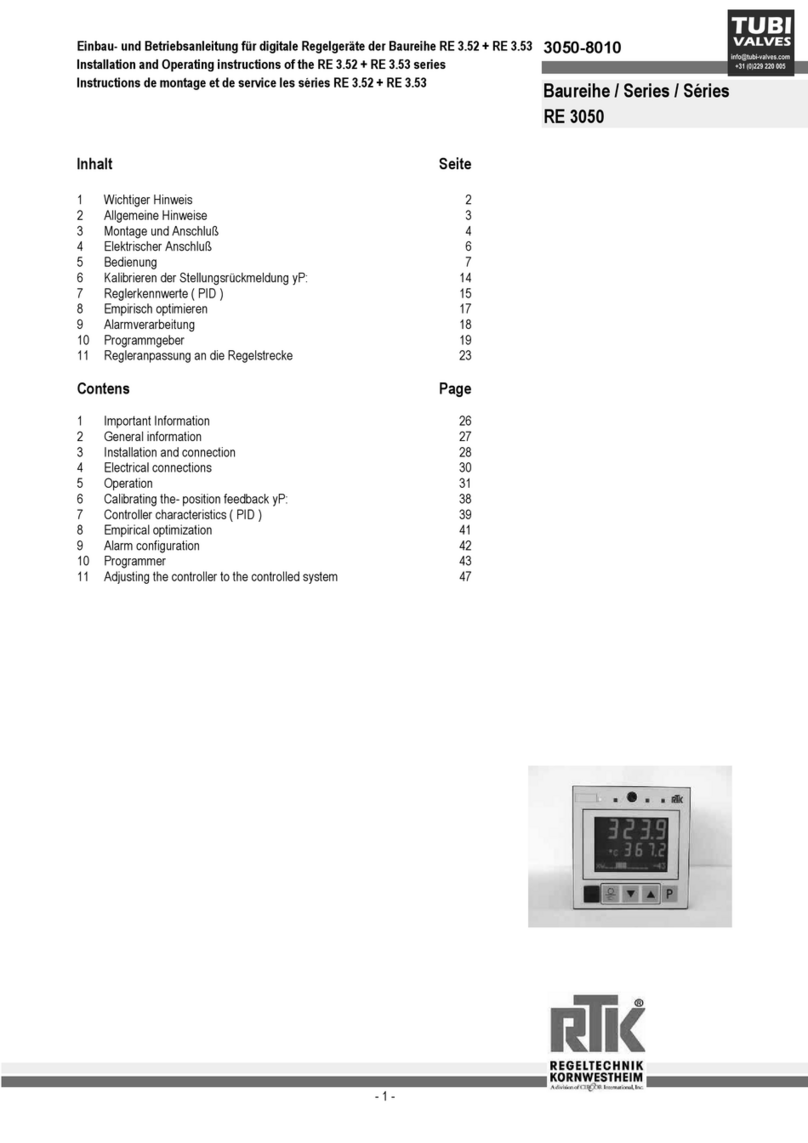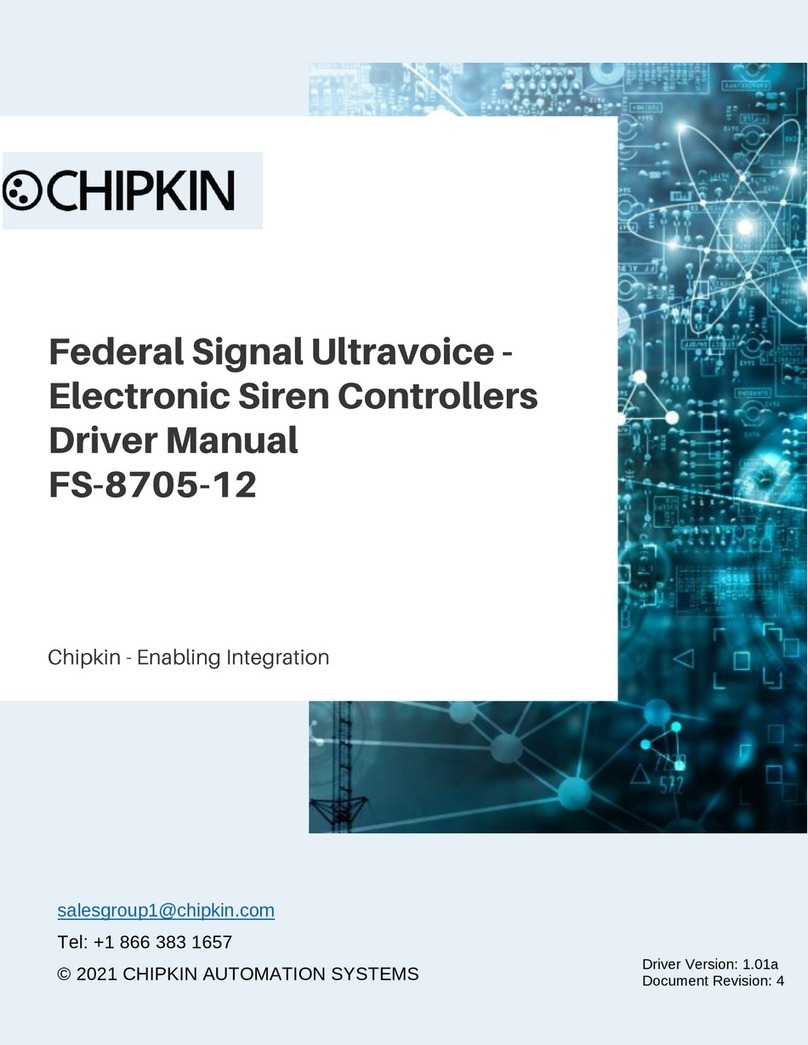TAS PowerTek TPF-56 User manual

LT Intelligent Automatic Power Factor Controller
& Data Logger
For Capacitor-Duty Thyristor Switches,
For High-Speed Power Factor Correction
TPF-56
User Manual
Version 1.1.5
Updated on: 22nd March 2016.

NOTE
These instructions do not purport to cover all details or
variations in equipment, nor to provide for every possible
contingency to be met in connection with installation,
operation or maintenance.
Should further information be desired or should particular
problems arise which are not covered sufficiently for the
purchasers purposes, the matter should be referred to our
office.
The contents of this instruction Manual shall not become
part of or modify any prior or existing agreement or
relationship. Any statements contained herein do not create
new warranties or modify the existing warranty.
The reproduction, transmission or use of this
document or its contents is not permitted
without express written authority. Offenders
will be liable for damages. All rights are
reserved.
Intelligent Power Factor Controller TPF-56
CAUTIONS:
1. There are High Voltages associated with this Unit. So, take appropriate
precautions.
2. To be installed & commissioned by a technically qualified person only.
3. Make sure that the discharge time set in the controller matches
the capacitor discharge time!
4. This Automatic Power Factor Controller (APFC), TPF-56, is to be used
indoor only.
5. Make sure that the Capacitor Bank Discharge Time set in the PF
Controller matches with the actual Capacitor Bank Discharge Time.
6. This User Manual is applicable to TPF-56 Unit with Firmware
Version 1.0.7 as on 25 JAN, 2016.
Because of continuous improvements carried out by TAS PowerTek in their
Product’s Features and Specifications, the Product as well as the Content of the User
Manual is likely to get updated without any prior notice.
Therefore, please always refer to the User Manual supplied to customer along with
the Product, at the time of product dispatch.
!
2 of 56 Version 1.1.5 22nd March, 2016

Index
Section Page No.
Index page -- 3
Ordering Information -- 4
Features -- 5
Specifications -- 8
Functional block diagram -- 15
PF correction technique -- 16
Typical wiring scheme -- 18
Front fascia -- 19
LCD display contrast & backlit -- 22
Display of various parameters -- 23
Sub menu for display of parameters -- 24
Method of Keyboard / Display usage -- 26
Keyboard / Display operations -- 29
Edit Parameters -- 30
General & I/O -- 31
System -- 31
Fault -- 32
Steps -- 35
Communication -- 36
Utilization counter -- 37
Notes On Protection
and Functionalities -- 38
Fault indications and
Fault actions -- 40
Data logging facilities -- 41
Power-fail monitoring -- 42
Commissioning Instructions -- 43
Fault finding Guidelines and
Trouble shooting procedures -- 45
Factory Default Settings -- 47
Maintenance Copy
(Blank Forms for User) -- 52
Manufacturer’s Contact Details -- 56
Intelligent Power Factor Controller TPF-56
3 of 56 Version 1.1.5 22nd March, 2016

Ordering Information
Product Specific Information Number (PSIN)
TPF-56 / nn
nn: Number of Current-sourcing, 20 milli-Amps Current-Limiting, Transistor
Output stages: 04,08, 12, or 16.
Please specify the “nn” while quoting, ordering, buying etc.
Note that the Isolated +12 V DC Supply is from User Side, and the “Return” for
all Command Outputs of TPF-56/nn are “Commoned” to 0 V of the +12 V DC
Supply, at the TAS Thyristor Switches Side.
The TPF-56 Units with TAS Capacitor-Duty Thyristor Switches make ideal
combinations for Applications in Welding Shops, Reciprocating PistonAir-
Compressors, ElectricArc Furnaces, Induction Furnaces, Rolling-Mills etc.
Intelligent Power Factor Controller TPF-56
4 of 56 Version 1.1.5 22nd March, 2016
(SimilarAPFC Unit is available with Potential-Free, Normally-Open (N. O.)
Relay Contacts, as SPF-56, for Medium-Speed, P. F. Corrections, based on Three-
Phase, Capacitor-Duty, Power Contactors & Three-Phase, Delta Connected Power
Capacitors, with Discharge Resistor and optional Current-Limiting I de-tuned
Inductive Reactors in EACH Phase to the Power Capacitor.
The SPF-56 Firmware is compatible for the Relays and the Contactors based
Medium-Speed PF CorrectionApplications with TAS Reactors and Capacitors.
Please contact TAS PowerTek, Nasik, India, for further details.)

Features:
•Totally Micro-Controller based logic for measurements, monitoring,
analysis & control.
•Functionality Suitability: LT PF correction application for Distribution
Transformers secondary side used by Electricity Distribution
Companies, Private Industries, Offices, Establishments etc.
•Protection and Functionality to take care of Supply System
abnormalities and various faults.
•Protection against internal faults and its controlled components like
Capacitor Banks and switching thyristor.
•Communication port RS-232 for logged data downloading and for
other convenience functionalities.
•Completely Fire Retardant ABS grade plastic material body with
sufficient ventilation for cooling.
•Externally replaceable battery slot for maintenance convenience. This
battery is used primarily for RTCC –“Real Time Clock-Calendar” to
work during supply power down condition.
•LCD –16 Char. x 2 Line Yellow-green Backlight and Black Characters,
Display for Display of various parameters, symbols & functionalities
requirement.
•Keypads with soft touch 7 Nos. of keys for Scrolling between various
displays and various functionalities / settings.
•Power supply and measurement range is wide-ranging and highly
reliable operation under various supply system PQ issues like supply
voltage dips / swells, transients, cycle loss etc.
•Reliable Screw type terminals for fork/ring type lugs with externally
replaceable fuse protection for transistor outputs.
•Capacitor Banks –same value Equal Utilization logic.
Intelligent Power Factor Controller TPF-56
5 of 56 Version 1.1.5 22nd March, 2016

Features (Continued):
•Capacitor Banks actual value measurement in terms of KVAr (reactive
power) normalized values for rated supply voltage and frequency, for
monitoring it’s health. This is on-line monitoring with complex
algorithm for getting right values under variable loading conditions
authentically.
•Measurement and Display of Various Electrical values:
3-phase Voltages (Line –Neutral Values)
3-phase Currents and Neutral Current.
Individual Phase PF, Active Power, Reactive Power, Apparent
Power values.
AC Mains Supply Line frequency.
Overall Values: Average Voltage & Current, Total Active Power,
Total Reactive Power, Total Apparent Power.
Energy Values: Active Energy Consumed, Reactive Energy
Inductive (uncompensated), Reactive Energy Capacitive
(uncompensated), Apparent Energy.
Harmonics: Per Phase V-THD-F% and I-THD-F% values up to 15th
odd harmonics.
Capacitor Bank Values: Normalized for rated supply voltage and
frequency and monitored on line.
Temperature of the Unit.
Battery Voltage for RTCC / NV-RAM Battery.
•Data Logging: Unit has sufficient Non-Volatile memory to log hourly,
30min,15min,10min readings and to log last 1024 events. The
Parameters are logged for downloading on PC based program “Data
View” for viewing and report generation purpose.
The Logged values for viewing and report generation are:
Unit ID, Sr. No., Date / Time stamp.
3-phase Voltages (Line –Neutral Values)
3-phase Currents.
Supply frequency.
Overall Power Values: Total Active Power, total Reactive Power,
total Apparent Power.
Energy Values: Active Energy Consumed, Reactive Energy
Inductive (uncompensated), Reactive Energy Capacitive
(uncompensated), Apparent Energy.
Harmonics: Maximum value of Phase V-THD-F% and I-THD-F%
values.
Intelligent Power Factor Controller TPF-56
6 of 56 Version 1.1.5 22nd March, 2016

Features (Continued):
Capacitor Bank Values: Normalized for rated supply voltage and
frequency and monitored on line.
All Capacitor Bank Status.
Temperature of the TPF-56 Unit.
Battery Voltage for RTCC / NV-RAM Battery.
•Data Mobilizer –In future, we will add Hand Held Unit (HHU-01) as a separate
unit, that can be procured separately for transfer of data from remote site
located TPF-56 Unit that can be further uploaded to PC having “Data View”
software. Such Unit even have added facilities like fixed set parameter
uploading (5 pre-programmed sets of Parameters to be programmed in TPF-
56).
•Manual Mode (Testing) facility available for convenience of checking the Turn-
On and Turn-Off of capacitor banks. This feature is additionally useful for
Manual Synchronization and for resetting the “faulty” declared capacitor banks.
•GSM (global system for mobile) :
Enabling GSM send SMS about various parameter :
3-phase Voltages (Line –Neutral Values)
3-phase Currents and Neutral Current.
Bank status .
Fault.
•RS485 communication :
There are two basic transmission modes found in serial MOD-BUS
connections, ASCII and RTU. These transmission modes determine the
way in which the MOD-BUS messages are coded.
One of the main differences between MOD-BUS/ ASCII and MOD-BUS RTU
is that ASCII allows gaps between the bytes of a message with a
maximum length of 1 second. With MOD-BUS RTU, continuous streams of
messages must be sent. Enabling Modbus ASCII or RTU gives values:
3-phase Voltages (Line –Neutral Values)
3-phase Currents and Neutral Current.
Individual Phase PF, Active Power, Reactive Power, Apparent Power values.
AC Mains Supply Line frequency.
Overall Values: Average Voltage & Current, Total Active Power, Total
Reactive Power, Total Apparent Power.
Energy Values: Active Energy Consumed, Reactive Energy Inductive
(uncompensated), Reactive Energy Capacitive (uncompensated),
Apparent Energy.
Harmonics: Per Phase V-THD-F% and I-THD-F% values.
Capacitor Bank Values: Normalized for rated supply voltage and
frequency and monitored on line.
Temperature of the Unit.
Intelligent Power Factor Controller TPF-56
7 of 56 Version 1.1.5 22nd March, 2016

Specifications of TPF-56/xx Unit:
1. Rated supply values:
3 –Phase, 4 –Wire supply system.
Line-to-Line rated voltage 440VAC sinusoidal.
Rated frequency 50Hz(+/-3Hz) Or 60Hz(+/-3Hz)
2. Auxiliary Supply:
Line to Line sinusoidal voltage range 100VAC - 500VAC.
Supply frequency range 47 Hz to 63 Hz.
Supply VA burden –8 VA maximum. (typical 6 VA)
Protected by externally replaceable 0.8 A/500VAC slow-blow
glass type standard fuse.
3. Metering (measurement) Input:
Voltage Input:
Voltage 3-Ph, 4-Wire with Ph-N values range of measurement
as 60 VAC to 300VAC.
Voltage Measurement burden < 1VA per phase.
Current Input:
Current measurement through secondary current of 3 Nos of
Current transformers with secondary rated current as either
1Amp or 5Amp AC.
Current measurement range: 1.5%INominal to 130%INominal
For 1Amp terminals: 15mA to 1.3Amp.
For 5Amp terminals: 75mA to 6.5Amp.
Maximum current withstanding capacity: 4xINominal for 1 Second.
Maximum VA burden on CT: < 1VA.
Measurement Values and Accuracy:
Per phase Voltage, Per phase & neutral Current,
Overall Power and Overall Energy values with accuracy class
1.0 as defined in IS-14697 with all Amendments till date.
This is for Active & Reactive Power / Energy.
Intelligent Power Factor Controller TPF-56
8 of 56 Version 1.1.5 22nd March, 2016

Specifications (continued):
5. Transistorized Output:
Total No. of Transistorized Output for capacitor banks
switching ON / OFF : Maximum up to 16 Numbers.
Voltage & Current Rating, Transistorized O/Ps (Short-Circuit Protected) :
+12 VDC to +24 VDC, Current-Sourcing Output, 20 mA max.
Protected by Glass cartridge fuse –200mA,+12/24V DC/fast blow.
6. Connection Terminals (rear side):
All the connectors are on rear side and suitable for connecting
fork type copper lugs with 1.5mm2or 2.5mm2wires.
Maximum applicable torque on Screws of Terminal while
tightening is 0.5 Newton-meter. Recommended torque
calibrated screw driver adjustment is 0.35 N-met.
Voltage rating across 2 adjacent terminals –380VAC.
Continuous Current rating (RMS value) –8 Amp.
7. Battery for RTCC (Real Time Clock-Calendar) & NV RAM:
Battery type to be used : CR2032. (Maxell make preferred)
Battery Voltage (New) : 3.3VDC to 3.1VDC.
Low Battery Alarm : 2.6VDC. (Range 2.65VDC to 2.55VDC)
Battery Fault Indication : < 1.8 VDC.
Expected Battery Life: @ 2½ Years to 3 Years.
Time frame for Battery replacement after Low Battery Alarm
is Maximum 6 months. Recommended period < 3months.
8. Data Log Non-Volatile Memory:
Used for TPF-56 Program Parameter storage, 1 Hour, 30min,15min,10min
interval data log, latest 1024 events data log and Power-down values
storage with “Early-Warning-Power-Failed (EWPF)” sequence.
Critical storage even with RTCC Battery Fail or Replacement for
ensuring no data loss or maintain Energy values.
Intelligent Power Factor Controller TPF-56
9 of 56 Version 1.1.5 22nd March, 2016

Specifications (continued):
9. Mechanical Dimensions:
Intelligent Power Factor Controller TPF-56
Mounting
Clamps
All 4 sides.
10 of 56 Version 1.1.5 22nd March, 2016
All Dimensions in mm.
146 mm
95 mm
•Un-packed net weight of the Unit: 880 gm.

Front fascia
LCD Display
RS-232 port with
dedicated protocol.
Key pad
I AM OK LED
(Controller
“Health”
status LED)
Intelligent Power Factor Controller TPF-56
Specifications (continued):
11 of 56 Version 1.1.5 22nd March, 2016
Leds for indication
of status of
Capacitor Banks

Back side terminals
Note:
Use appropriately rated and type, while replacing the fuse(s) in the field
Measurement voltage
(Line To Neutral 300VAC max)
Auxiliary Supply
Voltage
(100V to 500 VAC)
Load current CTs
F1: Fuse for Auxiliary
Supply ( 0.8 A/500 VAC
slow-blow glass
Cartridge.)
Intelligent Power Factor Controller TPF-56
Specifications (continued):
12 of 56 Version 1.1.5 22nd March, 2016
F2: Fuse for Capacitor
Banks 1 to 8
(200mA,+12/24 VDC
Fast- blow,
Glass Cartridge).
Output commands
to Thyristor switch
1 to 8 Outputs.
F3: Fuse for Capacitor
Banks 9 to 16
(200mA,+12/24 VDC
Fast- blow,
Glass Cartridge).
Output commands
to Thyristor switch
9 to 16 Outputs.

Other Auxiliary Arrangements:
RTCC Battery insertion slot.
Intelligent Power Factor Controller TPF-56
Battery Slot for replacement
Of CR2032, 3 Vdc Li. Battery.
(Remove black sticker over the slot
to see the battery inside)
Recommended to change the Battery
with Auxiliary Supply to Unit in ON
condition. RTCC would not be disturbed.
Ensure new battery replacement with
Correct polarity. Use tips insulated, thin
& long nose plier to remove old battery
& insert the new battery.
In case the Aux. Supply was OFF and then
this RTCC Battery is replaced, user will
have to set RTCC once again to correct
date & time.
- +
Side view of TPF-56 for seeing Battery insertion slot.
The unit after mounting in panel is compatible for
enclosure protection class as per DIN 40 050:
Front side: IP-54.
Back side: IP-10.
Specifications (continued):
10. Environmental Requirements:
Operating temperature range: 0°C to +55°C.
Storage temperature range: 0°C to +65°C.
Altitude: up to 3500 meters above sea level.
Relative Humidity range: 10% to 95% RH (Non-condensing).
11. Standards Compatibility:
Unit is designed to comply with following standards compliance.
Safety Standards: IEC61010-1:2001
EMI Standards: CISPR 11
EMC Standards: IEC61000-4-2:8kV
IEC61000-4-4:4kV
IEC61000-4-11:Class A.
Accuracy Standards: IS14697: Class 1.0
13 of 56 Version 1.1.5 22nd March, 2016

Intelligent Power Factor Controller TPF-56
Specifications (continued):
9. Jumper Selection for RS485 and GSM communication
(Continued):
14 of 56 Version 1.1.5 22nd March, 2016
Fig: Berg Jumpers selection for RS232 or RS485 Interface.
Fig: Connector for RS232 and RS485
Selecting positions 1 & 2 in both JP1 and JP2
enables RS232 communication for external GSM
Modem.
Selecting positions 2 & 3 in both JP1 and JP2
enables RS485 for MOD-Bus ASCII or MOD-Bus
RTU protocol.
Contact us for RS232 to RS 485 converter
module for RS 485 communication between TPF-
56 and PC / PLC’s RS-232 Port, with Auto-Data-
Direction Control.
Figure shows connector for RS232 and RS485
Communication. RX and TX for RS 232
communication and D- and D+ for RS485
communication. Note that the Signal Ground
Terminal is common for RS-232 or RS-485.
Contact us for Separate Documents for MOD-Bus
and GSM Functionality Implementations.
Note:
Please remove the 5-way mating connector of
RS-232/RS-485 while installing the Unit in the
DIN Standard Cut-out on the Panel Door, and
replace it after the installation is done.
3
2
1
3
2
1
DI (RS485)
TX 1
TXD1 (RS232)
RO (RS485)
RX 1
RXD1 (RS232)
JP1
JP2
D+ (RS485)
D- (RS485)
GND
TXD-GSM(RS232)
RXD-GSM(RS232)

V, I, PF and Power
Measurement
Block
Three channel
Supply (load)
current feedback
Front-Panel RS-232 for
Data Downloading
Calculation
Block for
•Energy Parameters
•Harmonic analysis
•Capacitor kVAr
Power
Supply
Keyboard,
Display &
other support
function
block.
Power Factor
Correction Block
+ event monitoring.
Outputs Commands
For Capacitor
Switching.
Transistorised o/p
Capacitor
switching
commands
Serial
Communication.
Channels - 2 Ports.
Functional Description:
Functional Block Diagram
Intelligent Power Factor Controller TPF-56
RTCC & Non-
Volatile Memory
for:
•Interval Log
•Event Log
•Prog. Param
•Critical data
with EWPF
logic.
15 of 56 Version 1.1.5 22nd March, 2016
3Ph 4Wire
Voltage feedback
Rear-Panel
RS232/RS485

Functional Description (Continued):
PF correction technique
KW.
KVAR
(Ind)
KVAR
(Cap)
PFLOWER.
PFUPPER.
-KW.
PFLOWER.
PFUPPER.
Case-1: PF-UPPER & PF-LOWER both set as inductive:
smallest
Capacitor bank
kVAr x 1.5 width.
KVAR
(Ind)
KVAR
(Cap)
PFLOWER.
PFUPPER.
-KW
PFLOWER.
PFUPPER.
smallest
Capacitor bank
KVAR X 1.5 width.
Case-2: PF-UPPER as Capacitive & PF-LOWER set as Inductive:
KW
No change band.
Capacitor addition band.
Capacitor removal band.
Intelligent Power Factor Controller TPF-56
16 of 56 Version 1.1.5 22nd March, 2016

There are two PF set-points to be set in TPF-56/16. The UPPER limit and
the LOWER limit. TPF-56 ensures that PF-UPPER is never exceeded.
Additionally, “No change band” to minimum KVAR band size equal to
smallest bank KVAR x 1.5 ensures no hunting during the low KW loading.
TPF-56 is normally set for PF settings as per first two diagrams shown
where PFLOWER is inductive. This philosophy helps to optimize the
system maximum KVAR to be used as well as reduces the number of
switching operations during higher loading conditions. This ensures better
life expectancies of the switched capacitors as well as the switching
devices.
This methodology of KVAR compensation reduces the complex settings
that are used by conventional PF relays. The settings like C/K ratio and
KVAR offsets/shifts are eliminated which makes TPF-56 user friendly and
thus easy to commission.
For all the three conditions shown in the above diagrams, 4-quadrant
operation is achieved. Typical example of 4-quadrant operation is “Co-
Generation Plants” and “Wind-Power Generation”. But with most
conventional consumer applications, only +Ve KW is seen, where the
Auto Synchronization feature can be used.
KVAR
(Ind)
KVAR
(Cap)
PFLOWER.
PFUPPER.
-KW
PFLOWER.
PFUPPER.
smallest
Capacitor bank
KVAR X 1.5 width.
KW.
Case-3: PF-UPPER & PF-LOWER both set as Capacitive:
No change band.
Capacitor addition band.
Capacitor removal band.
Intelligent Power Factor Controller TPF-56
17 of 56 Version 1.1.5 22nd March, 2016

Typical wiring diagram for PF correction
Intelligent Power Factor Controller TPF-56
18 of 56 Version 1.1.5 22nd March, 2016
PH1
PH2
PH3
N
L
O
A
D
TPF-56
CapacitorBank1
CapacitorBankn
S1S2
P1P2
S1S2
P1P2
S1S2
P1P2
Fuse
Fuse
Fuse
Fuse
Fuse
Fuse
External
+12/+24V
DCSupply
+0V
1Amp
EXT
Ground
CMD
+
_
CMD
+
_
ExternalDCSupply
EXTGround
ExternalDCSupply
EXTGround
ThyristorSWn
ThyristorSWn
PH1 PH2 PH3 N C 1A 1A 1AC C5A 5A 5A
PH2 PH3PH1
T1
T8
EXT
T9
T16
EXT
L1 L2
Fuse
Fuse Fuse

Front fascia –
LCD screen
First line of display indicates the PF value, inductive / capacitive PF,
mode of operation and fault /OK status:
“PF = 1.000” indicates the overall PF of the system.
“+” or “-” indicates if this PF is inductive or capacitive respectively.
“A” or “M” indicates the Auto and Manual mode of operation respectively.
“ ” or “ ” indicates the Mains and Generator mode of operation respectively.
“OK” (blinking) indicates status of the system, healthy or faulty.
Last two characters represent one of the following status:
Second line indicates the status of each capacitor bank by symbols.
‘I AM OK’ Blinking LED indicates the controller’s health status ,i.e. the
controller is working okay. If this LED stays continuously ON or
continuously OFF, then, it means the Controller is not functioning properly.
OK Controller status is OK
ZV Zero voltage
OV Over voltage
UV Under voltage
VH Voltage over-harmonics THD%
IH Current over-harmonics THD%
BF Battery Fail for Battery or RTC faulty
ZC Zero current in any one phase
Intelligent Power Factor Controller TPF-56
AS Auto-Synchronization Pending
19 of 56 Version 1.1.5 22nd March, 2016
- I am OK (Blinking Green colour LED) to indicate the
healthy state of Controller.
OB
Out of Banks (Insufficient Total
Capacitive kVAr –Warning.
OT
Over Temperature
UF
Under Frequency
OF
Over Frequency
UL
Under Load
BL
Low Battery Warning
OC
System Over Current Warning
PF=+1.000 A OK
_ _ _ _ _ _ _ _ _ _ _ _ _ _

Example of a typical LCD display screen is show below:
Meaning of this screen contents:
Total no. of banks connected is 16.
Power Factor at Load sensing CT is ‘+1.000’
‘+’ indicates Inductive.(‘-’ indicates Capacitive)
Unit is operating in ‘A’ Auto mode. (‘M’ defines Manual mode)
“ ” indicates controller is on mains.
“ ” indicates controller is on Generator.
Total number of banks that are operational are 16.
Bank no. 1 is declared as fixed and is in ON condition.
Bank no. 2 is in ON condition.
Bank no. 3 is declared as faulty.
Bank no. 4 is in discharging state.
Bank no. 5 to 16 are in OFF condition.
“I AM OK”, flashing Green LED indicates the controller health status.
This LED is located at the extreme, left-hand, bottom side of the front
panel, as viewed by the user.
This LED, if continuously ON or continuously OFF, indicates
malfunctioning of the controller.
On powering up the unit, there is power-on discharge time given
for the capacitors to discharge completely. However, if the user is sure
that the capacitors are discharged, then on pressing the left key would
allow the controller to come out of the discharge time and thus user
need not wait for the discharge time to get complete and thus saves
time.
Front fascia –
LCD screen
This port is used for downloading of data logged in the controller.
The interface is Standard, 3-wire, RS232. For further description about
the data logging, please refer Page No. 36 of this user manual.
Following gives the pin configuration:
Front side RS232 communication port connection
Intelligent Power Factor Controller TPF-56
20 of 56 Version 1.1.5 22nd March, 2016
Table of contents
Popular Controllers manuals by other brands
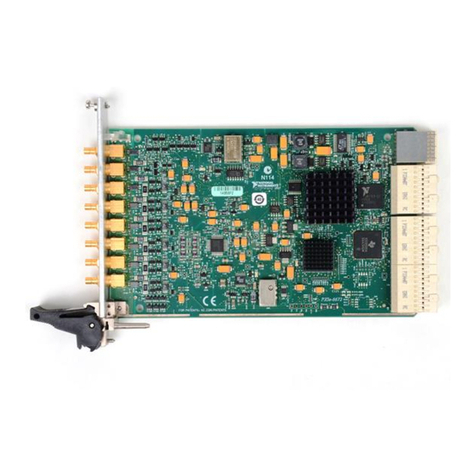
National Instruments
National Instruments Network Adapter NI PXIe-6672 installation guide
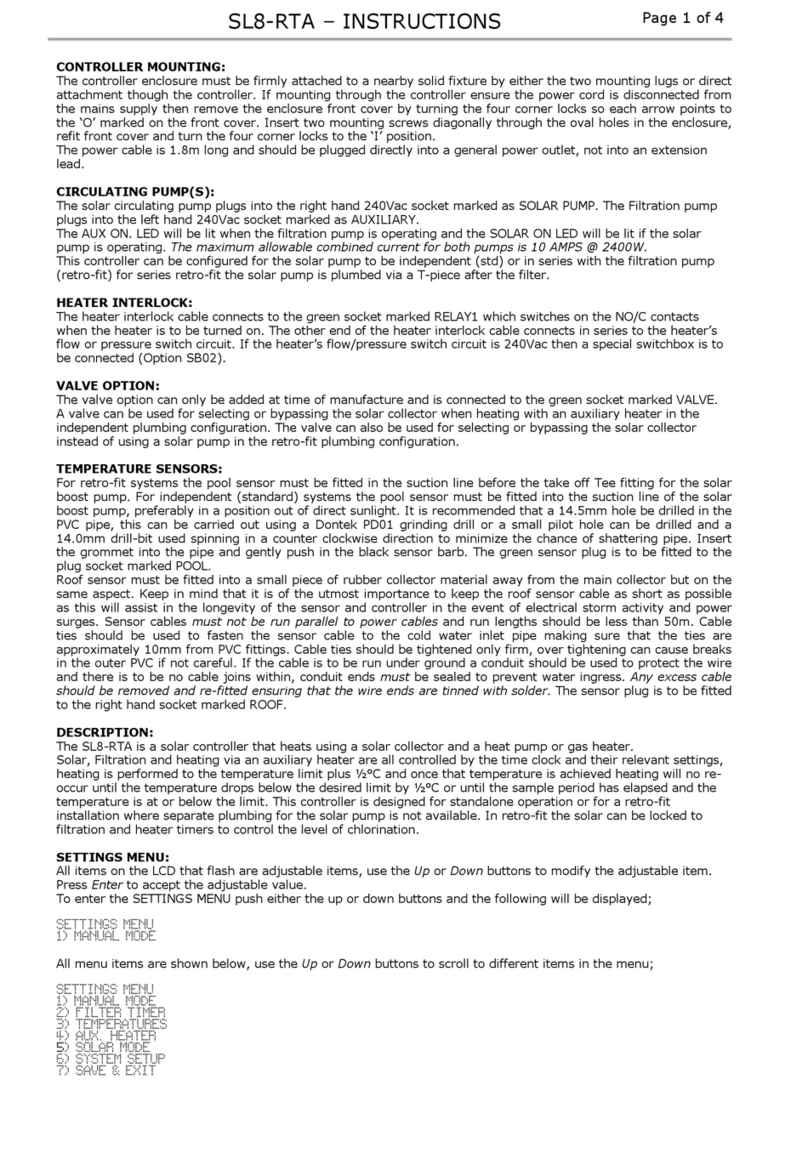
Sunlover
Sunlover SL8-RTA instructions
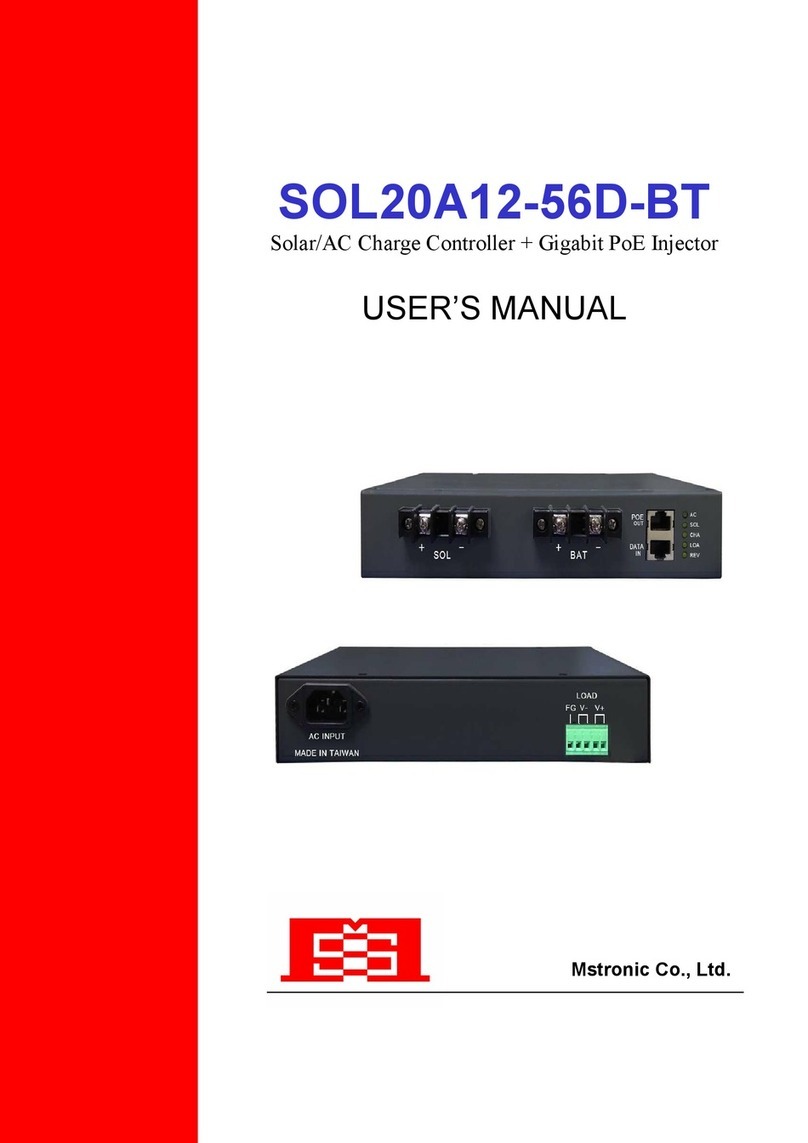
MSTRONIC
MSTRONIC SOL20A12-56D-BT user manual
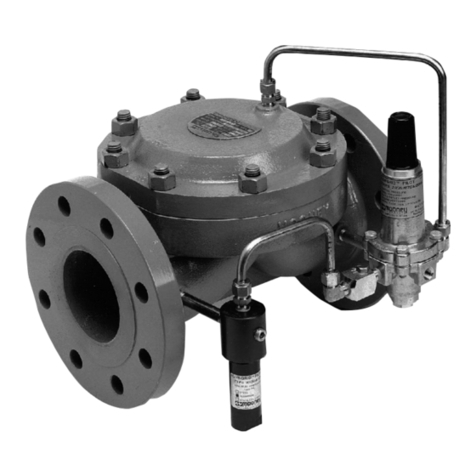
GE
GE Mooney Flowgrid instruction manual
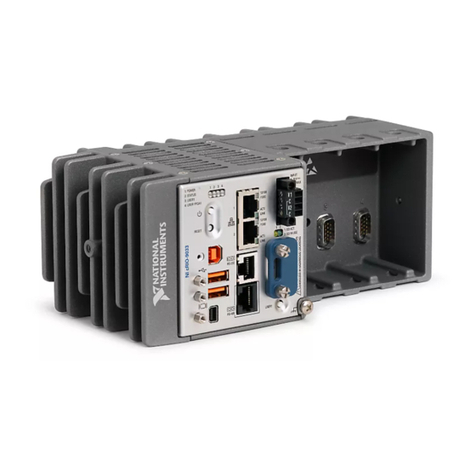
National Instruments
National Instruments cRIO-9031 user manual
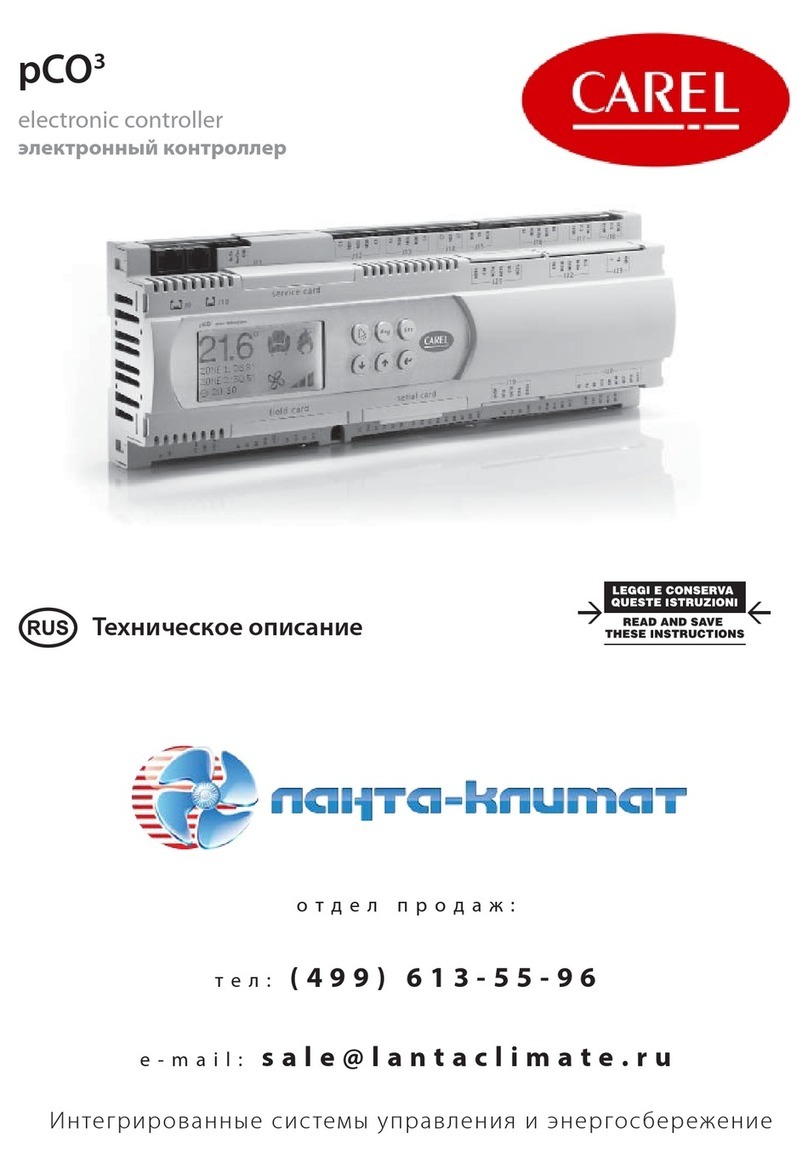
Carel
Carel pCO3 series Technical leaflet

